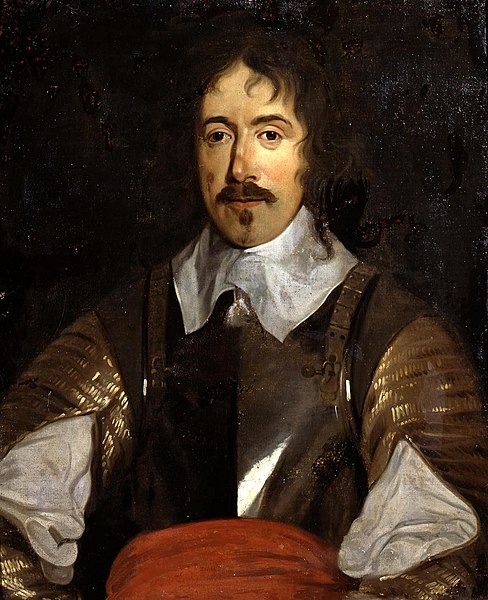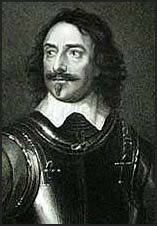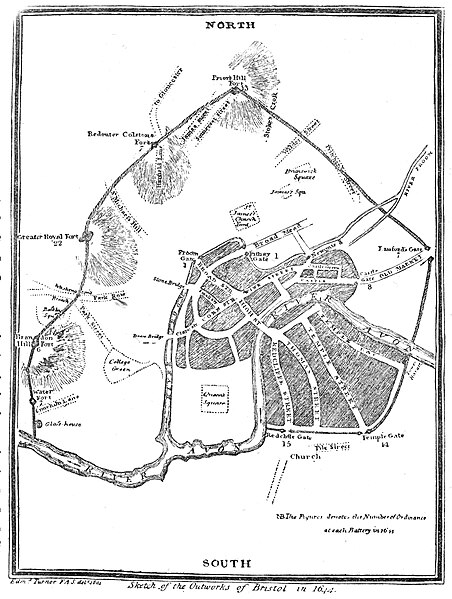 |
| Prince Rupert |
First Blood
A mythology
started to arise around Rupert and tales of his antics grew apace; one time in Stafford Rupert stood in the garden of a Captain Sneyd and shot at the
weathercock of St Mary’s Church. He hit it from a range of 60 yards[i] and upon Charles
dismissing the shot as a fluke Rupert repeated his feat.
Tales of his
abilities expanded to bestow on Rupert almost supernatural powers of disguise
such that he went selling apples to the Parliamentarian army. Rupert’s height,
at 6’ 4”, precluded most of the outrageous feats attributed to him. The
Parliamentarian propagandists presented Rupert as a highborn scoundrel and one
of his nicknames in the early part of the war was ‘Prince Robber’.
One task
given Rupert early on was the escorting of the silver belonging to Oxford
University to the safety of Shrewsbury. Resting at Powick bridge Rupert and his men were taken by
surprise by 1,000 Parliamentarians. Rupert led a counter charge and within half
an hour Rupert’s men had the Parliamentarians on the run. Lord Falkland wrote that;
‘Prince Maurice hath
received two or three scars of honour on his head, but is abroad and
merry……[Rupert] ventured as far as any trooper of them all’[ii]
but he was
unwounded in the fight.
Edgehill and After
 |
| Lord Forth, Earl of Brentford |
The first
major set to in the war came on 23rd October 1642 at Edgehill. The Earl of Essex was the Parliamentarian commander,
known as a cuckold amongst the royalists. Rupert had already challenged Essex,
on 10th October, to a battle at Dunsmore Heath, accusing him of wanting the crown for himself.
The
royalists had originally planned to occupy Banbury on 23rd; instead they found themselves fighting Essex’ men. A
successful cavalry charge saw Rupert’s men chase their opponents off to Kineton while the foot soldiers were attacked by Essex’ reserve cavalry.
‘The King’s horse being all
gone off, his foot is charged by a part of the enemy’s horse which put them in
disorder.’[iii]
The
following day the Parliamentarians withdrew to Warwick while the royalists occupied Banbury on the 27th and made a
triumphal entry into Oxford on the 29th. The Earl of
Lindsay died during the fighting and Charles appointed Lord
Forth as his general in chief. Forth acted
as Charles chief of staff while Rupert was given the task of consolidating the
defences around Oxford and Reading. He made an attempt on Windsor Castle on 7th November and was repulsed[iv].
London in Sight
 |
| Denzil Holles |
In November
Charles moved to Colnbrook and urged his nephew to attack Brentford where Rupert surprised two Parliamentarian infantry
regiments. His men pushed the forces commanded by Denzil Holles back into the town and the
Parliamentarians finally withdrew to Uxbridge under the protection of John Hampden[v] and his men. The Royalists captured 15 guns and 11
colours and about 500 prisoners, including John Lilburne who was a captain in Lord Brooke's regiment.
Afraid that
London would suffer Brentford’s fate, Rupert became the target of vicious
Parliamentarian propaganda. Lord Wharton, who fought at Edgehill, claimed
that;
‘The troops under the
command of Prince Rupert…..not only pillaged the baggage[vi]……but
killed countrymen that came in with their teams, and poor women and children
that were with them.’[vii]
 |
| Lord Wharton |
Rupert was
furious at Wharton’s slanders, but they were believed by many. The
Parliamentarians used Wharton’s claims to persuade Londoners to defend their
city against the potential rampages of the Cavalier army.
Encouraged
by the victory at Brentford Charles consented to push on to London, but on 13th
November at Turnham Green the royalists met with the Earl of Essex and his army. Neither side
wanted to engage; a few cannon shots were exchanged; then Essex reoccupied
Brentford. Against Rupert’s advice Charles withdrew to Reading and returned
back to Oxford. His army was never to gain control of London.
John Gwynne,
one of Charles’ Welsh soldiers, defended Charles’ decision;
‘Nor can anything of a
soldier or an impartial man say that we might have advanced any further to the
purpose towards London than we did……the common road and other passes, were
planted with their artillery, with defensible works about them.’[viii]
No Hope for Peace
 |
| Cirencester |
Between
January and April 1643 the two sides bent their efforts, conducting peace
negotiations at Oxford. The parliamentarian demands were unrealistic and
included Charles getting rid of the bishops and demobilising his army, along
with handing over his key supporters to Parliament for punishment.
As the talks
dragged on Rupert remained on the offensive. In February Rupert attacked Cirencester[ix] with 6,000 men. It took four hours
to capture the town which refused an offer to surrender. Once again false
propaganda dogged Rupert; the stories emanating from London claimed that Rupert
sanctioned the murder of Puritan ministers and women and children.
 |
| Lord Denbigh |
Rupert
overcame a Parliamentarian force at Alton in Hampshire in late February before attacking the enemy in
Wiltshire; speed and surprise the essence of his attacks. Henrietta Maria
landed in Yorkshire on 22nd February, bringing reinforcements and
much needed armaments from the continent. Rupert was sent with 12,500 men to clear
a route for the queen through the hostile midlands.
Rupert took Birmingham[x] on 3rd April;
‘The Prince took Birmingham
by assault with little loss, only the Lord
of Denbigh[xi] was
unfortunately slain.’[xii]
The
opposition claimed that Rupert’s men defiled the women of Birmingham and set
the town ablaze[xiii].
By the middle of the month he’d taken Lichfield, occupied by Parliamentarians.
More Victories
 |
| Earl of Essex |
In Rupert’s
absence the Earl of Essex laid siege to Reading and Rupert was ordered back to
Oxford. By the time Charles and Rupert met at Caversham. Reading had fallen to the
opposition. Outnumbered the deputy governor Sir Richard Fielding surrendered
and he and his men marched out of the town. Fielding was court-marshalled and
sentenced to death; at Rupert’s intervention Fielding was taken down from the
scaffold.
Essex then
took Thame and sent an advance guard to Wheatley, only five miles from Oxford. On 18th
June the two armies met at the battle of Chalgrove Field. Rupert was chasing after a convoy
escorting a large sum of money to Thame. Following a daring leap over a hedge
by the Rupert’s cavalry the Parliamentarians fled and John Hampden was mortally
wounded.
Essex
withdrew to Aylesbury while Rupert established himself at Buckingham, forcing Essex to draw back to north Bedfordshire.
Rupert’s victories meant safe passage for Henrietta Maria to join Charles at
Edgehill. A week after Henrietta Maria’s return Rupert set off with a large army
intending to take either/or Bristol or Gloucester, clearing the route to Wales.
Rupert’s
road was clear as Ralph Hopton had taken much of the south west
with three battles at Stratton, Landsdowne and Roundway Down. Maurice took part in the battle of
Roundway Down and General Waller was comprehensively defeated,
retiring to Gloucester with the rump of his forces.
 |
| Bristol outer defences |
As Waller
was now ensconced in one of his objectives, Rupert chose to attack Bristol, the
second largest port in the country. On 25th the Cavalier army attacked the town defended by a force under Sir Nathaniel Fiennes,
an amateur soldier. Rupert’s horse was killed under him during the fighting.
‘His Highness having
recovered another horse, rode up and down from place to place, here directing
and encouraging some, and there leading up others; generally it is confessed by
the commanders that had not the Prince been there, the assaults, through mere
despair, had been in danger of being given over in some places.’[xiv]
Fiennes
surrendered and looting of the town started, which Rupert tried to prevent.
Fiennes recorded that Rupert and Maurice;
‘Did ride among plunderers
with their swords hacking and slashing them.’[xv]
Rupert
apologised for failing to control his men. Always indecisive, Charles had
already charged Rupert with returning a large part of his cavalry as Essex had
returned to Aylesbury. But learning of his nephew’s success at Bristol, Charles
decided to journey there himself intending to attack Gloucester.
The
relatively inexperienced Maurice[xvi] was placed in charge of
the army in the west, replacing the Marquis of Hertford, while Rupert was
ordered to increase funds and recruit more men.
Bibliography
Prince
Rupert of the Rhine – Maurice Ashley, Purnell Book Services Ltd 1976
The English
Civil War – Robert Ashton, Weidenfeld & Nicholson 1989
The Memoirs
of Elizabeth Stuart Vol 1-2 – Elizabeth Benger, General Books LLC 2012
Charles the
First – John Bowles, Weidenfeld & Nicholson 197529th.
Charles I –
Christopher Hibbert, Penguin Books 2001
The Civil
Wars of England – John Kenyon, George Weidenfeld & Nicholson 1989
Prince
Rupert of the Rhine – Patrick Morrah, Constable & Company 1976
The English
Civil War – Diane Purkiss, Harper Perennial 2007
Prince
Rupert – Charles Spencer, Phoenix Paperback 2008
[i]
A prodigious feat with the unreliable firearms of the time
[ii]
Prince Rupert - Spencer
[iii]
Rupert of the Rhine - Ashley
[iv]
The castle was the Parliamentarian military HQ throughout the war
[v]
Cromwell’s cousin
[vi]
Wharton was not averse to pillaging on his own behalf
[vii]
Prince Rupert - Spencer
[viii]
The English Civil War - Purkiss
[ix]
Which housed a large Parliamentary garrison
[x]
A centre of arms manufacture
[xi]
His son fought on the Parliamentarian side
[xii]
Prince Rupert - Spencer
[xiii]
Birmingham was burnt against Rupert’s wishes
[xiv]
Rupert of the Rhine - Ashley
[xv]
Ibid
[xvi]
He had hitherto only commanded cavalry
Definitely one of those larger than life characters who manages to look dashing even in the horrid short-waisted jerkins that were fashionable and make all the men look pregnant.
ReplyDelete